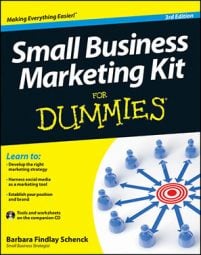One-to-one marketing through direct mail targets your small business customers. Direct mailers focus your marketing communications on your best prospects, while also providing a simple way to measure their success.
The best direct mailers feature the following materials and information:
A clear offer: Feature the offer on the envelope, the letter, the letter’s postscript, and any additional enclosures.
A free response mechanism: Allow the customer to respond at no expense, whether through your website, a toll-free number, or a postage-paid card. Be sure to collect complete customer data, including an e-mail address, allowing you to later invite the person to opt in for future digital communications.
A reply card: Some people prefer to mail in their responses, even if you also invite a response through a toll-free number or web address. On your reply card, give people a chance to say yes or no. It’s counterintuitive, but giving them the chance to decline your offer increases the chance of them accepting it.
To save money, contact your post office or a mailing service for help obtaining a business reply mail permit. That way you pay only for the responses you receive rather than paying to place a stamp on every reply card you enclose.
A letter: People may tell you that no one reads the letter or that the letter just gets in the way of other enclosures, but they’re wrong. Unless your mailer takes the form of a postcard or self-mailer, the letter is an essential ingredient of direct mail.
How to send your small business direct mailers
The U.S. Postal Service website offers instructions, advice, resources, postal rate information, and a service called Every Door Direct Mail that distributes mailers to all homes on a postal route without using individual addresses.
The post office gives this advice for sending mailers:
For a small mailing, it’s probably easier to skip presorting and simply stamp and send your mailers.
For larger mailings, a mail service provider can help you select postal services and handle many of the details and much of the legwork.
To handle your own large mailing and to qualify for commercial pricing, be prepared to do your own presorting, meet postal regulations, apply for postal permits, pay an annual bulk mail fee, send at least 200 identical pieces in each mailing (containing no checks or bills), include zip codes on each piece, and presort and bundle the mail following postal specifications.
To simplify presorting, use a list that’s CASS (Coding Accuracy Support System) certified. When you purchase outside lists, ask to see the CASS certificate that the U.S. Postal Service provides.
You can receive further discounts by using zip+4 codes and adding bar codes that support the post office’s automated systems. Various kinds of bar codes earn different discounts. Inquire at the post office or ask a mail consultant about the requirements to receive reduced rates.
Respond quickly to your small business direct mailing
Half of all responses arrive within two weeks of the date that people receive a direct mailing in their mailbox, but keep your expectations in check. A 1 to 3 percent response rate is considered a home run with a purchased or outside list. If you use internal lists that are full of highly qualified names, you can hope for a higher return.
Don’t wait even one week to get back to your direct mail respondents. If you don’t think you can handle the volume of responses in a timely manner, send your mailers out in flights — groups of several hundred every three or four days. This ensures that the responses are staggered as well. Do the following in your response:
Thank the respondent for the inquiry. Many people forget that they sent in a card, so refresh their memories.
Provide the item that you promised in your initial mailing, along with a description that highlights its value.
Introduce your business in terms of benefits that matter to the consumer. Remember that product features and customer benefits are different.
Offer the next step in the buying process. Include an introductory offer, invitation, coupon for service, or some other means to heighten interest in an effort to convert the prospect into a customer.
Create a database of respondents
After fulfilling the request, enter the respondent’s name into a database for timely future contacts. Within eight weeks, contact prospects a second time by mail, phone, or — if they’ve invited you to do so — an e-mail newsletter or update.
As you enter names into your database, include
The source of the lead
The date of the first and each subsequent contact
The respondent’s name, mailing address, and e-mail address
Information that can help you customize future contacts (such as the answers to questions that you asked on your reply card)
Additional space in which you can log follow-up activity
If your business has a limited number of prospects, you can maintain this database manually. But if you’re managing a larger number of leads, consider using a customer relationship management software or a database management company.
Send a second small business mailing to non-respondents
Within 30 days of your first mailing, contact recipients who haven’t yet responded. (If you’re using an outside list, rent the list for two-time usage and obtain a duplicate set of labels for this purpose.)
Research proves that following up with non-respondents increases your overall response rate dramatically. Doing so also gives you much more value for the cost of the list rental because the second-time usage is usually a fraction of the cost of the initial usage.
You can also make the second-round contact via e-mail or phone. With any approach, your objective is to build on the first contact and move the prospect closer to buying action.

